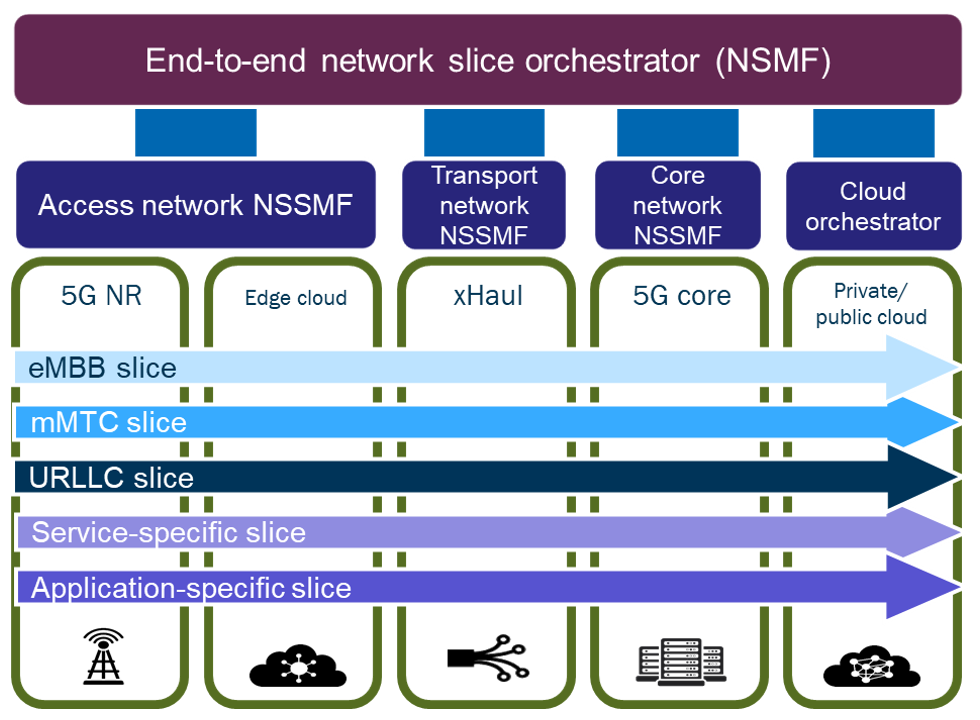Software-defined transport provides the basis for 5G network slicing
5G network slicing empowers communication service providers (CSPs) to offer a new suite of differentiated services featuring on-demand, customer controlled self-service options. A network slice is an end to end, logically separate network partition with unique network performance and latency characteristics to serve a particular use case or enterprise.
To deliver true network slicing, CSPs need a cross-domain network slice orchestration architecture that stitches together domain-level slices to form an end-to-end slice spanning the RAN, edge, transport, and the core network domains. In the architecture implemented by Telefonica iFUSION, the software-defined transport network (SDTN) controller is used to provide the domain-level slice management capability.
 Anil Rao is the Research Director and Lead Analyst for network and service automation research at Analysys Mason, covering a broad range of topics on the existing and new-age operational systems that will power operators’ digital transformations.
Anil Rao is the Research Director and Lead Analyst for network and service automation research at Analysys Mason, covering a broad range of topics on the existing and new-age operational systems that will power operators’ digital transformations.
His main areas of focus include automation of service creation, provisioning and service operations in NFV/SDN-based networks, 5G, IoT and edge clouds; the use of analytics, ML and AI to increase operations efficiency and agility; and the broader imperatives around operations automation and zero touch networks.
End-to-end 5G network slicing is enabled by SDN, NFV and cloud native computing
The CSP community, the vendor ecosystem and enterprises in many industries recognize that 5G is not just another generation of mobile technology. Instead, 5G will allow enterprise applications that require very low latency, very high availability, very high data rates and very high device density – all on the same network. Most importantly, 5G will provide advanced multi-tenancy and network slicing, allowing CSPs to address the unique specialised performance requirements of a variety of industries at an affordable price.
5G network slicing is possible thanks to innovations such as software defined networking (SDN), network function virtualisation (NFV) and cloud native computing (CNC). These technologies provide the key building blocks for a flexible, dynamic and a programmable 5G network platform. SDN introduces dynamicity in the transport network through programmatic control of the traffic management and routing – which is required to guarantee slice-based performance in the transport network. NFV and CNC provide the foundational technologies for on-demand service creation, smart scaling, smart workload placement, and lifecycle management of control plane and user plane resources to reflect the use case requirements.
CSPs can use these capabilities to create separate ‘end-to-end network slices’, which in turn allow for use case and SLA-driven slice instantiation, and network function placement based on the specific latency, performance, reliability and availability requirements of that use case. The network slices run in isolation and pave the way for CSPs to offer differentiated slice-based services for whole industries; or granular, differentiated slices for each use case, subscriber type, application or enterprise - with slice-level control, management, and quality of service. Network slicing also lets enterprises create multiple services within their own network domains without the help of service providers.
Transport SDN controller provides the domain level slicing capability in the transport network
According to the high-level network slice management framework published by 3GPP, the network slice management function (NSMF) and the network slice subnet management function (NSSMF) are the two key components required to develop a slicing solution. (Figure 1). The NSMF will perform cross-domain network slice orchestration and the NSSMF will perform the intra-domain slice management. This architecture allows for the instantiation and configuration of network slice resources for each of the use case types – enhanced mobile broadband (eMBB), massive IoT (mIoT) and ultra-reliable low latency communication (uRLLC) services – in each subnet or domain, dictated by the end-to-end network slice intent and governed by the end-to-end slice orchestrator.

Figure 1: Network slicing orchestration stack architecture, as specified by the 3GPP.
Transport domain network slicing will be enabled by new IP routing technologies, such as segment routing, that can be configured to address key slice characteristics such as the QoS and path forwarding policy. A SDTN controller will supplement this to provide on-demand configuration, thereby providing a higher level of dynamic control for transport network slices.
The key to achieving transport network slicing at scale is to build and maintain a catalogue of predefined slice forwarding templates, along with the slice attributes such as the quality of service, path forwarding policy, connectivity end points, and slice performance. The SDTN controller, based on CSP policies, can instantiate the most suitable template when an enterprise requests a slice, and dynamically configure the slice attributes as they are instantiated. With this approach, tens or hundreds of slice instances can be automatically instantiated using a limited set of slice types.
Telefonica iFUSION hierarchical SDTN controller provides the basis for transport network NSSMF capability
Telefónica Germany has implemented a hierarchical SDTN controller architecture for its partially disaggregated optical network, which includes decoupled open terminals (OTs) and an open line system (OLS). It has deployed Blue Planet’s Multi-Domain Service Orchestration (MDSO) for multiple hierarchical SDTN controller use cases in order to manage their multi-vendor optical network. The SDTN controller can be used in the role of NSSMF for the optical network, while the higher layer multi-domain SDN controller (encompassing the IP/MPLS, microwave and optical domains) can perform the role of NSSMF for multi-domain transport network slicing.
You can learn more in this case study, which provides a detailed overview of the Telefonica Germany implementation.
